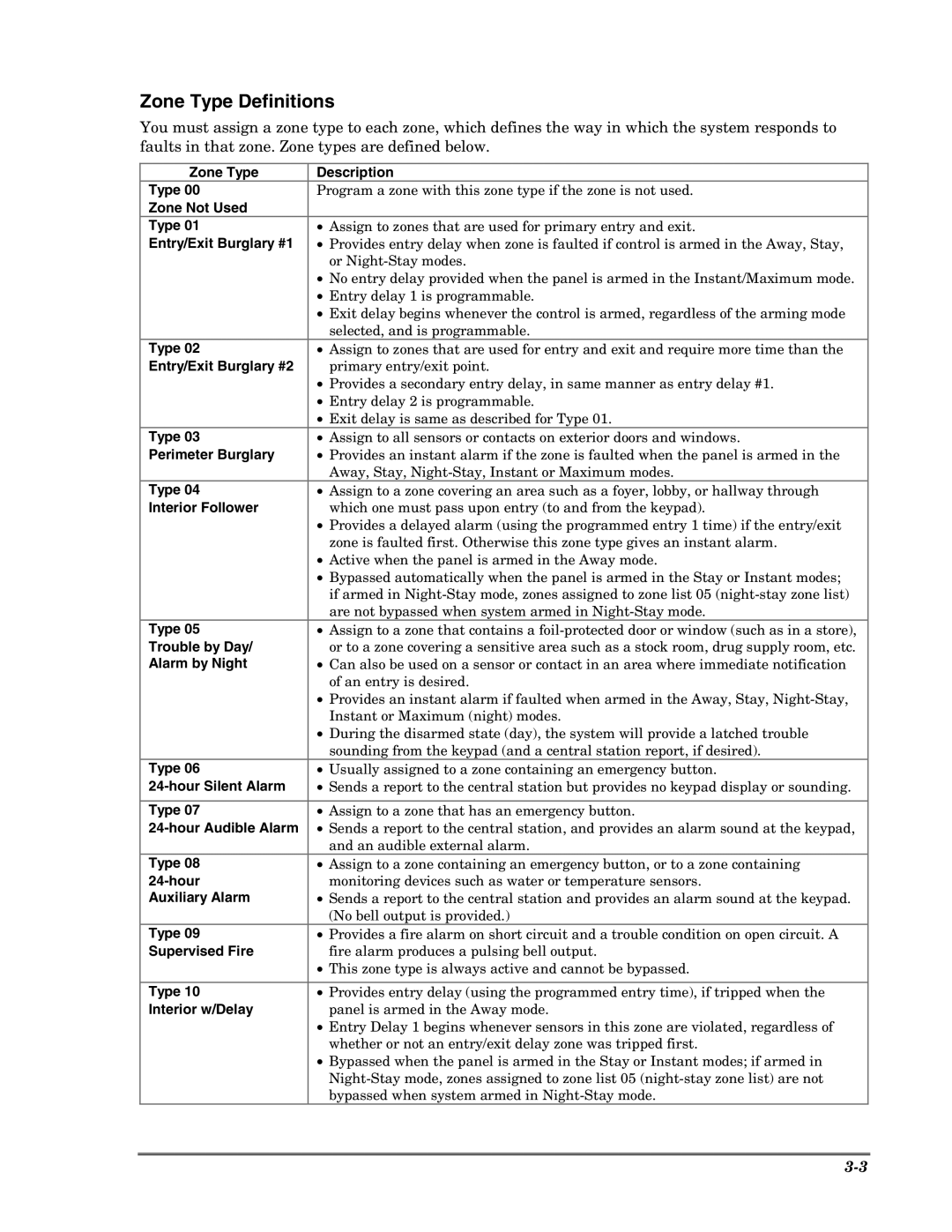Zone Type Definitions
You must assign a zone type to each zone, which defines the way in which the system responds to faults in that zone. Zone types are defined below.
Zone Type | Description |
Type 00 | Program a zone with this zone type if the zone is not used. |
Zone Not Used |
|
Type 01 | • Assign to zones that are used for primary entry and exit. |
Entry/Exit Burglary #1 | • Provides entry delay when zone is faulted if control is armed in the Away, Stay, |
| or |
| • No entry delay provided when the panel is armed in the Instant/Maximum mode. |
| • Entry delay 1 is programmable. |
| • Exit delay begins whenever the control is armed, regardless of the arming mode |
| selected, and is programmable. |
Type 02 | • Assign to zones that are used for entry and exit and require more time than the |
Entry/Exit Burglary #2 | primary entry/exit point. |
| • Provides a secondary entry delay, in same manner as entry delay #1. |
| • Entry delay 2 is programmable. |
| • Exit delay is same as described for Type 01. |
Type 03 | • Assign to all sensors or contacts on exterior doors and windows. |
Perimeter Burglary | • Provides an instant alarm if the zone is faulted when the panel is armed in the |
| Away, Stay, |
Type 04 | • Assign to a zone covering an area such as a foyer, lobby, or hallway through |
Interior Follower | which one must pass upon entry (to and from the keypad). |
| • Provides a delayed alarm (using the programmed entry 1 time) if the entry/exit |
| zone is faulted first. Otherwise this zone type gives an instant alarm. |
| • Active when the panel is armed in the Away mode. |
| • Bypassed automatically when the panel is armed in the Stay or Instant modes; |
| if armed in |
| are not bypassed when system armed in |
Type 05 | • Assign to a zone that contains a |
Trouble by Day/ | or to a zone covering a sensitive area such as a stock room, drug supply room, etc. |
Alarm by Night | • Can also be used on a sensor or contact in an area where immediate notification |
| of an entry is desired. |
| • Provides an instant alarm if faulted when armed in the Away, Stay, |
| Instant or Maximum (night) modes. |
| • During the disarmed state (day), the system will provide a latched trouble |
| sounding from the keypad (and a central station report, if desired). |
Type 06 | • Usually assigned to a zone containing an emergency button. |
• Sends a report to the central station but provides no keypad display or sounding. | |
|
|
Type 07 | • Assign to a zone that has an emergency button. |
| • Sends a report to the central station, and provides an alarm sound at the keypad, |
| and an audible external alarm. |
Type 08 | • Assign to a zone containing an emergency button, or to a zone containing |
monitoring devices such as water or temperature sensors. | |
Auxiliary Alarm | • Sends a report to the central station and provides an alarm sound at the keypad. |
| (No bell output is provided.) |
Type 09 | • Provides a fire alarm on short circuit and a trouble condition on open circuit. A |
Supervised Fire | fire alarm produces a pulsing bell output. |
| • This zone type is always active and cannot be bypassed. |
|
|
Type 10 | • Provides entry delay (using the programmed entry time), if tripped when the |
Interior w/Delay | panel is armed in the Away mode. |
| • Entry Delay 1 begins whenever sensors in this zone are violated, regardless of |
| whether or not an entry/exit delay zone was tripped first. |
| • Bypassed when the panel is armed in the Stay or Instant modes; if armed in |
| |
| bypassed when system armed in |
